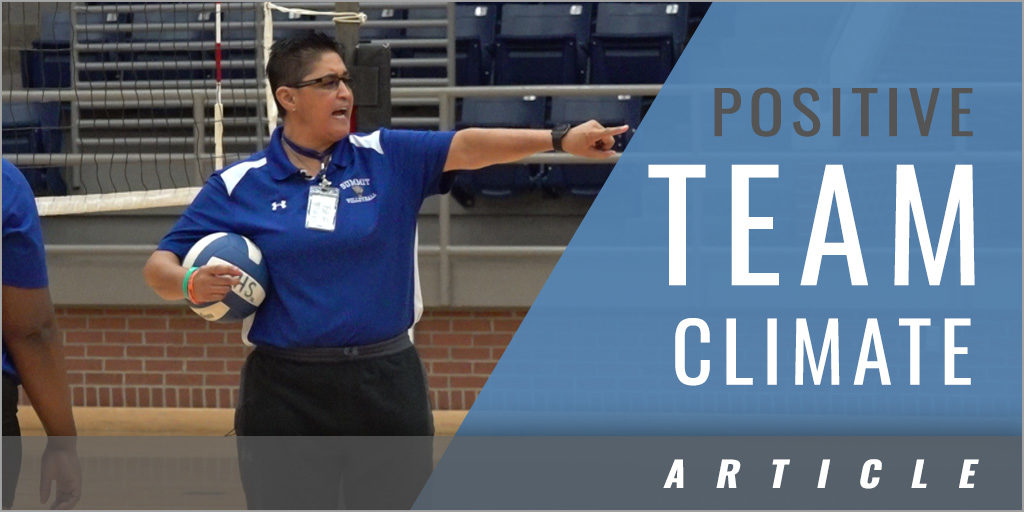|
By: Becky Schmidt Originally Published in: The Volleyball Coaching Bible Volume II Provided by: Human Kinetics A positive team climate is one in which athletes improve their ability and learn more about their potential. The feedback they receive from their coaches, each other, and the environment contributes to both of these objectives. Telling players what they do well, although positive, does not help them maximize their skills. Focusing on the negative, for most athletes, results in frustration and decreased self-confidence. Again, the coach's task is to find a balance between the two as well as provide multiple sources of feedback. Coach-Player In my experience, athletes desire two types of feedback from their coaches:
At Hope College we want our coaches working hard to provide both types of feedback. We want to acknowledge and celebrate when our athletes succeed, both in result and process. I went through a phase in my coaching when I felt as though telling players "great pass" after getting the ball to target was redundant. They could see that the pass was perfect and didn't need me to tell them. I found that my athletes appreciated my praising their passes (or any other obvious demonstrations of skill) because pleasing me was important to them. This is further demonstrated in how often my players ask, "Coach, did you see that?" when they achieve success at something they have been working on. The athlete knows that she was successful, but she wants to share that success with me. In addition to praising successful execution, we also want to praise successful process. Specific feedback on techniques that improve athletes' chances of success or attempts that are outside their comfort zones are worthy of encouragement. It helps to know exactly what your players are working to improve, so that you can give appropriate feedback when you see them make progress. Write down their goals or objectives, as well as the areas in which you would like to see them improve, and carry it with you during practice. Sharing those goals with your assistant coaches will keep them engaged and help them know where they can make a contribution. When I realized that praising both success and progress toward goals was valued by my players, I also realized that I could be much more specific than just saying, "Great pass." We don't have a lot of time to convey a lot of information, so we use specific cues to convey exactly what led to the success. During one afternoon of our preseason, we spend a couple of hours in volley-school (an idea taken from the U.S. national team program), in which we explain all of the coaching cues our staff uses and exactly what each word means. This cuts down on needing to use whole sentences to explain the specifics of what the athlete did well or poorly; we need only one or two words that are well understood. We use words such as balance, square, plant, and press to convey specific aspects of skills quickly. You can use instructional feedback with motivational feedback to let your athletes know specifically what led to their positive results. Have a manager track the type of feedback you provide to see whether you are as positive, specific, and motivational as you can be. The Positive Coaching Alliance (www.positivecoach.org) uses the phrase emotional gas tanks to convey athlete's emotional health. Praise, instruction, opportunity, and positive body language add to the emotional gas tank of an athlete. Criticism, punishment, and decreased opportunity result in emotional gas tank withdrawals. Keeping an eye on the emotional gas tank of each player on the team (how often you have made additions and how often you have made withdrawals) will help you predict how they will respond to the feedback. This is not to say that you should never make a withdrawal. Sometimes it is important to be critical, to uphold a standard, or to let athletes know that their behavior, attitude, or effort is unacceptable. However, in those situations, unless significant investments have been made, their motivation or self-confidence may diminish. Player—Player Players sometimes receive feedback from teammates more easily than from coaches. Such feedback can feel less threatening and also increase trust between teammates who are competing for the same position. We have developed a culture in which peer feedback is an important part of our program. The foundation is a lack of hierarchy within our team. For instance, we do not want our seniors to believe that they are any more important than our freshmen, or for sophomores to believe that they have any less value than juniors. We encourage our freshmen to give advice to seniors when they see an opportunity, and we ask our seniors to take the advice that they get from anyone with an outsider's perspective regardless of year. In our program, the first 15 to 20 seconds of time-outs involve players getting into position groups so that the players on the bench can tell the players on the floor what they are seeing. This also gives the coaches a few seconds to meet and put together a cohesive, concise message for the entire team. For drill work in practice situations, we break up the team into smaller groups; while one group is performing the drill, another is positioned to give feedback. When we are working on blocking, one player says yes or no to communicate whether the middle closes the block, another player along the net says yes or no regarding the blocker's hands getting over the net, and another player identifies whether the block is timed correctly with the attack. The goal for the blockers, regardless of the result of the block, is to get three yeses from the players giving feedback. How can you strategically position your players who are not involved in drill so that they can provide valuable feedback to the players in the drill? In a drill we call hot seat, which is a 6v6 scrimmage, one player is designated as the only one who can score a kill. One of our players did so well in that drill that a teammate bought a little red stool and wrote hot seat on it and put it in her teammate's locker to call attention to her great performance. When another teammate had a strong practice the next day, the first recipient of the hot seat passed it to her. Now, the little red stool moves from locker to locker as the previous recipient tries to identify the teammate who had the most impressive practice of the day. Such peer recognition goes a long way to build a team culture of encouragement, success, and positivity. |







